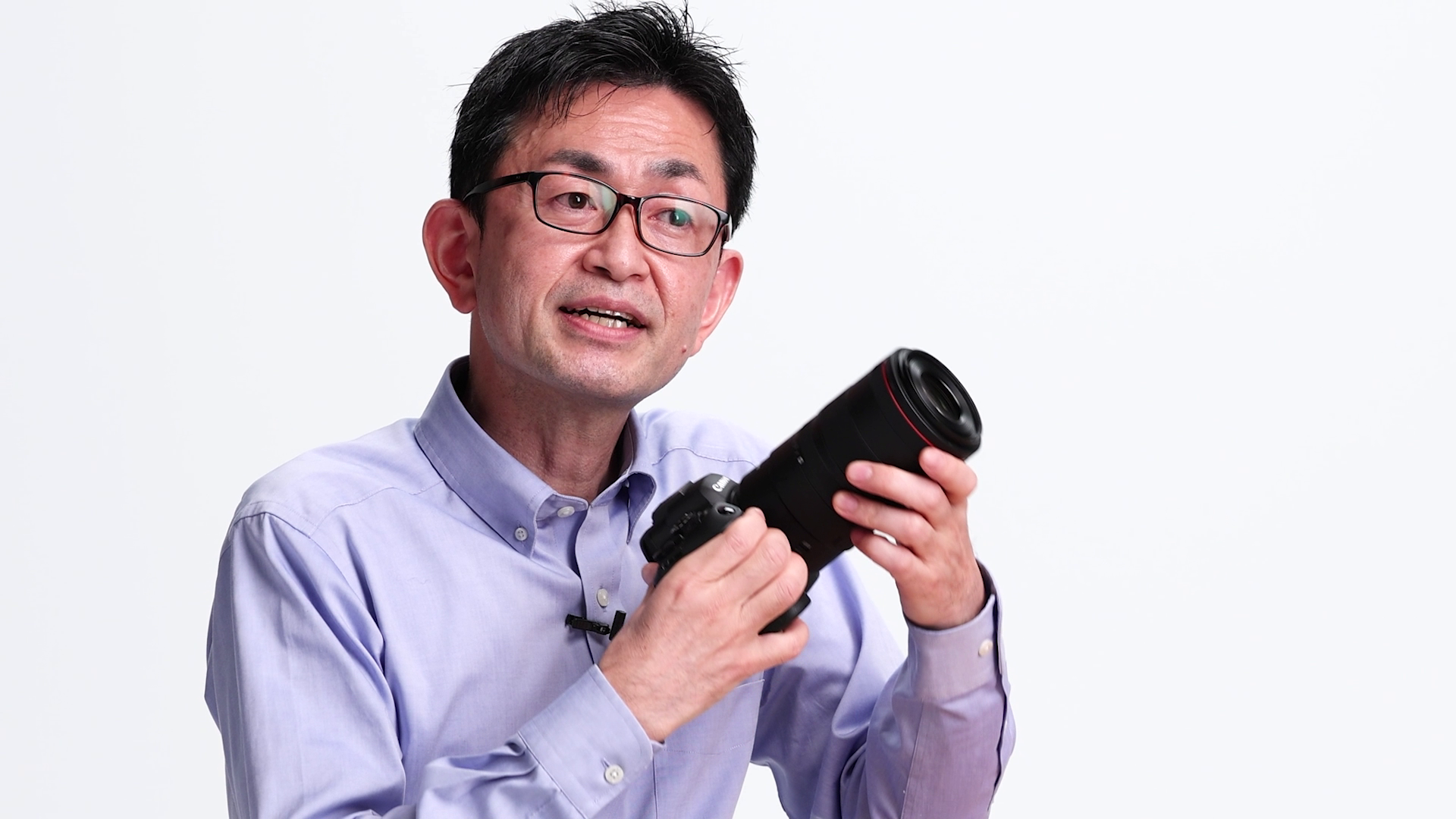RF70-200mm F2.8 L IS USM/RF70-200mm F4 L IS USM Developer Interview

(Left)Electrical designer: Taiki Honma
(Right)Mechanism designer: Kunihiko Sasaki
Process of downsizing
Canon’s efforts to develop these lenses began with the choice of the most appropriate optical design. Lens optical systems can be divided into two types: “fixed-length” and “variable-length”. The latter alters the overall length of the lens in order to achieve focus. This design has advantages for miniaturization, since it can make use of the unique short-back-focus characteristics of mirrorless cameras. On the other hand, the design does compromise some of the flexibility and ease of use that was typical of EF-era lenses.
Despite some reservations about this issue, Canon decided that users may be willing to compromise some degree of usability in return for better quality and a broader range of potential photographic expression. It is hoped that this will encourage existing Canon customers to adopt the new EOS R system.
F4 and F2.8 models
We actually considered adopting a fixed-length design for the F4 lens. This would differentiate it from the F2.8 design and also make it extender-compatible. However, we soon determined that this would make the F4 lens too bulky for most users. Since the basic structure of an F4 lens allows it to be made smaller than the F2.8 lens, we chose to take full advantage of this merit, adopting the same optical structure for the F4 lens as the F2.8 lens, and making it as small as possible.
Extender not supported
Adopting a new design for the RF series was a bit of a dilemma. We wanted users to be excited about the future potential of the EOS R system, but we are also aware that existing users may want lenses to be compatible with their extender. Unfortunately, when we tried to simulate a new lens design that would support an extender, we found that the overall length of the lens did not contract much at the wide-angle end. Therefore, it was not as compact as we had expected, especially compared to EF-era lenses.
While the EF70-200mm f/2.8L IS III USM was well received, some users complained that it was too bulky. In order to maximize the advantages of the interchangeable-lens system, when designing the RF70-200mm F2.8 L IS USM, we made the difficult decision not to make it compatible with extenders. This allowed us to reduce overall length dramatically — by about 25% compared to EF lenses.
When I first saw the F2.8 lens prototype, I was amazed at how small it could be. But the F4 lens is no less impressive. It has been miniaturized to about the same size as a standard F4 zoom lens.
The torque required to adjust the overall length of the zoom lens is greater, since the structure requires lens elements to be moved outward and inward. This makes the zoom ring harder to turn. We took great pains to ensure that the zoom ring would be light and easy to turn. In short, when we designed these lenses, we had to address a multitude of difficult issues in terms of miniaturization and extender compatibility.
Reduced weight
Naturally it is important for lenses to be lightweight, but I believe it is also important to have a good weight balance between the lens and the camera body. While taking steps to miniaturize RF lenses, Canon is also making EOS R cameras smaller and lighter.
We take into account how balance and size will be affected when the lens is attached to cameras such as the EOS R5 and R6. I think this is going to make things much easier for photographers who have to carry a camera around for hours at a time. I welcome feedback from people who use the new EOS system.
Optical design
The F2.8 and F4 lenses are based on the same general technologies. I’d like to discuss the optical design of these lenses in a bit more detail. In the past, zoom lenses in the 70-200mm range used a fixed-length type design. However, for the RF lens series Canon adopted a new optical system that uses a method called “multi-group zooming”, in which each lens group has a function that is not restricted by the old roles of variable magnification, focus, and aberration correction.
This lens was the first to adopt a drive motor to control the floating group. A floating group is a group of lens elements used primarily to cancel out aberrations. We set out to improve the basic performance of the lens by controlling the floating group with a motor, so that no matter the zoom position or focus distance, the lens captures images with beautiful quality and minimal aberration.
The use of this electronic floating system also helps to shorten the minimum focusing distance — from 1.2m with the f/2.8 EF lens to 0.7m with the f/2.8 RF lens. It is possible to design a lens that allows you to get closer to a subject at the wide-end setting, but users want to get closer at the telephoto end, too!
For this reason, the minimum focus distance of the f/4 lens has been reduced to 60cm. I think it is quite exciting to use this downsized 70-200mm lens to take pictures of a subject that is close enough to reach out and touch.
AF performance
We faced some difficulties in developing the electronic floating system. For example, if a delay occurs in adjusting the position, due to motor control, it could cause substantial aberration and inaccurate focus. We modified the control system in various ways to try to prevent this from occurring, but it was difficult to get it right the first time.
In fact, we encountered quite a few problems when we were field-testing the first prototype. It was difficult to get the camera to focus, and only after a lot of tinkering and many late-night discussions were we finally able to improve the performance to the point where it delivers photo results that we could be satisfied with.
It was extremely difficult to design a control system that could adjust the focal lens group to bring the subject into focus, while simultaneously controlling the floating group.
A good AF system needs to adjust the camera lens swiftly, to focus on the subject in a split second. However, with the new lens design, the positions of two separate lens groups have to be controlled simultaneously, with a micron-level degree of precision. Canon’s new control system accurately calculates not only the final stop position; it also the adjusts and compensates the position of the two lenses at every given moment during the focal adjustment, on a micron-by-micron basis, to avoid any deviation from the perfect focal position.
If this exact positioning is not maintained, aberration can occur during the focusing process, so a moving subject would not remain in focus. It took a lot of effort and repeated trial-and-error testing to finally produce lenses that can perfectly focus on a subject at high speed.
The result is something that photographers have long awaited — a camera that can focus on moving subjects and capture images with the same image quality as those of stationary subjects.
Reliability
As explained earlier, we adopted a type of zoom lens that changes in overall length as focus is adjusted. Of course, a zoom lens with a front that extends and contracts can be problematic, since the lens tip may accidentally bump into something as the lens focuses.
Therefore, we decided to employ six cam followers (parts that hold the movable lens barrel in place), to shift the front element on the barrel of the F4 lens, and twelve cam followers on the F2.8 lens. Both of these figures are double the normal number of cam followers to hold the lens barrel. After repeated in-house tests, we are proud to introduce these lenses as “genuine Canon 70-200mm lenses”.
High image quality
The image quality provided by these lenses has improved greatly. Not only have we suppressed spherical aberration at the center of the image; the peripheral image quality has also been improved by suppressing chromatic aberration and image curvature. This is partly thanks to the electronic floating system, as explained earlier. However, the choice of a variable-length optical design has also eliminated the need for an unreasonably long focal length for wide-angle settings, allowing for a more natural design.
The RF70-200mm F2.8 L IS USM is very good at resisting underexposure in backlit situations. For example, when taking photos of an approaching train, the camera is able to take clear photos of the entire train even in situations where the headlights of the train create a lighting dilemma. The development of new glass coatings and sophisticated simulation technology also contribute to this capability.
Other optical elements have evolved over the years. For example, the RF70-200mm F2.8 L IS USM was the first Canon camera to feature an aspherical UD lens. Although it is difficult to explain the technical reasons why, this helps to shorten the overall length of lenses by a few millimeters. Furthermore, the number of lens elements has been decreased, greatly reducing weight.
Image Stabilizer (IS)
Another major benefit of RF series lenses is their support for Coordinated Control IS with the camera’s in-body IS. The F4 lens is not as bright as the F2.8 lens, so the user may need to reduce shutter speed in some situations. When taking handheld photos at night, for example, a slow shutter speed may adversely affect photo quality.
However, Coordinated Control IS can achieve camera-shake blur correction as effective as an increase in shutter speed of up to 7.5 stops, making handheld photography much more practical. These and other technological innovations put the RF series of lenses in a paradigm unlike the EF era. I expect that Canon lens users will need to consider new factors when choosing an RF series lens.
Message to users
Canon’s 70-200mm lenses have already earned a strong reputation. When launching a major new product line, there may be a tendency to play it safe and try to avoid criticism by keeping things largely the same. One of the best things you can say about Canon is that we develop products with a bold spirit of innovation, and have the courage to try new approaches.
Naturally, there are pros and cons to any change in the basic product concept, but we think this lens can expand the range of photographic expression for users. We intend to incorporate customer feedback into future product development efforts, so we hope users will let us know of their experiences.
There is an unspoken understanding among RF lens developers that RF lens development cannot simply build on the things we did in the EF era. We approach every day with the idea of trying to incorporate something new or different with each and every lens we develop. The current 70-200mm lens is a good example: I think customers will be amazed at how compact and easy to handle it can be — something that would be impossible without the RF design.















